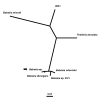Babesia divergens-like infection, Washington State
- PMID: 15200851
- PMCID: PMC3323086
- DOI: 10.3201/eid1004.030377
Babesia divergens-like infection, Washington State
Abstract
Most reported U.S. zoonotic cases of babesiosis have occurred in the Northeast and been caused by Babesia microti. In Washington State, three cases of babesiosis have been reported previously, which were caused by WA1 (for "Washington 1")-type parasites. We investigated a case of babesiosis in Washington in an 82-year-old man whose spleen had been removed and whose parasitemia level was 41.4%. The complete 18S ribosomal RNA gene of the parasite was amplified from specimens of his whole blood by polymerase chain reaction. Phylogenetic analysis showed the parasite is most closely related, but not identical, to B. divergens (similarity score, 99.5%), a bovine parasite in Europe. By indirect fluorescent-antibody testing, his serum reacted to B. divergens but not to B. microti or WA1 antigens. This case demonstrates that babesiosis can be caused by novel parasites detectable by manual examination of blood smears but not by serologic or molecular testing for B. microti or WA1-type parasites.
Figures


Similar articles
-
Babesiosis in Washington State: a new species of Babesia?Ann Intern Med. 1993 Aug 15;119(4):284-90. doi: 10.7326/0003-4819-119-4-199308150-00006. Ann Intern Med. 1993. PMID: 8328736
-
Identity of the causal agents of human babesiosis in Europe.Int J Med Microbiol. 2006 May;296 Suppl 40:131-6. doi: 10.1016/j.ijmm.2006.01.029. Epub 2006 Mar 9. Int J Med Microbiol. 2006. PMID: 16524772
-
The third described case of transfusion-transmitted Babesia duncani.Transfusion. 2012 Jul;52(7):1517-22. doi: 10.1111/j.1537-2995.2011.03467.x. Epub 2011 Dec 13. Transfusion. 2012. PMID: 22168221
-
Babesia sp.: emerging intracellular parasites in Europe.Pol J Microbiol. 2004;53 Suppl:55-60. Pol J Microbiol. 2004. PMID: 15787198 Review.
-
Molecular sequence evidence for the reclassification of some Babesia species.Ann N Y Acad Sci. 2006 Oct;1081:509-17. doi: 10.1196/annals.1373.076. Ann N Y Acad Sci. 2006. PMID: 17135560 Review.
Cited by
-
Emerging tick-borne pathogens of public health importance: a mini-review.J Med Microbiol. 2020 Jun;69(6):781-791. doi: 10.1099/jmm.0.001206. Epub 2020 Jun 1. J Med Microbiol. 2020. PMID: 32478654 Free PMC article. Review.
-
Activity Comparison of Epigenetic Modulators against the Hemoprotozoan Parasites Babesia divergens and Plasmodium falciparum.ACS Infect Dis. 2021 Aug 13;7(8):2277-2284. doi: 10.1021/acsinfecdis.0c00853. Epub 2021 Feb 18. ACS Infect Dis. 2021. PMID: 33599488 Free PMC article.
-
Tick-borne infections in children in North America.Curr Opin Pediatr. 2024 Apr 1;36(2):156-163. doi: 10.1097/MOP.0000000000001326. Epub 2024 Jan 3. Curr Opin Pediatr. 2024. PMID: 38167816 Free PMC article. Review.
-
Human babesiosis in Europe: what clinicians need to know.Infection. 2013 Dec;41(6):1057-72. doi: 10.1007/s15010-013-0526-8. Epub 2013 Oct 9. Infection. 2013. PMID: 24104943 Review.
-
Diagnosis and management of human babesiosis.Trop Parasitol. 2015 Jul-Dec;5(2):88-93. doi: 10.4103/2229-5070.162489. Trop Parasitol. 2015. PMID: 26629450 Free PMC article.
References
-
- Herwaldt BL, Springs FE, Roberts PP, Eberhard ML, Case K, Persing DH, et al. Babesiosis in Wisconsin: a potentially fatal disease. Am J Trop Med Hyg. 1995;53:146–51. - PubMed
MeSH terms
Substances
LinkOut - more resources
Full Text Sources
Other Literature Sources
Molecular Biology Databases
